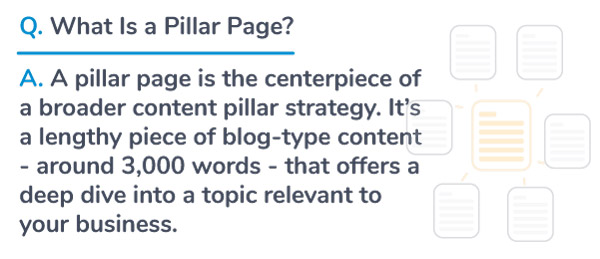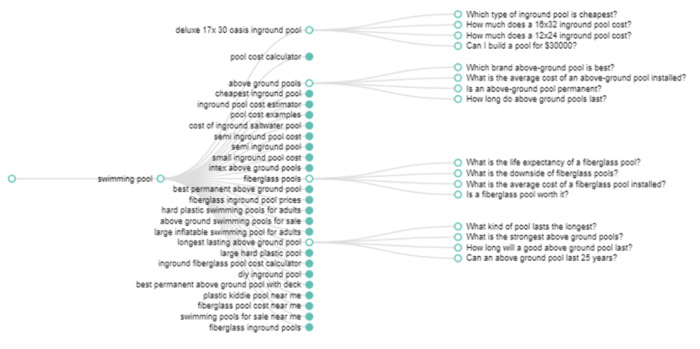Whether you’re an experienced content marketer or otherwise find yourself tasked with creating effective website content to drive traffic and prospective customers to a company website, it’s difficult to understate the importance of the pillar page strategy. To put it simply, when done right, this strategy leads to consistent results. It can be tough to get started, though.
In this post, we’ll cover the basics of creating your own content pillar page and provide a handy example you can use as a reference template. Following this will help ensure you cover the right bases and publish content that will get you where you need to be—page one of the search results, in the elusive 10% of content that gets all the clicks.
To help you understand not only what a pillar page is but also what an effective one looks like, we’ll be using our own SEO Pillar pillar as an example. (Yes, it’s a pillar about pillars. We’re serious. That being said, from this point, we’ll simply refer to it as “the SEO pillar”.)
- Before we continue: Clicking on the “SEO Pillar” anchor text in the sentence above will take you directly to the landing page where you can read the full, published pillar, which we’ll refer to throughout this piece. Go ahead and open it in a new tab, so you can switch over as needed.
We’ll start right in with the definition and purpose of a pillar page.
What Is a Pillar Page?
A pillar page is the centerpiece of a broader content pillar strategy. It’s a lengthy piece of blog-type content—around 3,000 words—that offers a deep dive into a topic relevant to your business and the customers you want to attract.
Within the larger context of a broad content strategy, a pillar page serves as the backbone of the entire content ecosystem, with a network of small, topic-specific blogs all branching off from (and linking back to) it.
For example, as pointed out above, this blog you’re reading now is connected to our SEO pillar, as a part of the larger strategy. We’re publishing a variety of blogs, all of which form a relevant content network with each including a hyperlink to the main pillar page. Blogs and linking are topics for another time, though—for now, let’s stay focused on the pillar page itself.

What Is the Purpose of a Pillar Page?
The purpose of a pillar page is simple—drive traffic to your company’s website, with the hope of hooking potential customers. A pillar page is meant to serve as a credible authority on a given topic—thereby positioning your company as a trustworthy source of information, or even a thought leader within the industry.
By way of example, our own SEO Pillar was written so anyone who searches a question related to SEO pillars will see our content in the 1st page of search results—if not the #1 spot. Whether someone is looking for basic information about writing an SEO pillar or needs to know the difference between a landing page and a pillar page, we aim to provide value in the form of answers.
How Do I Choose a Pillar Page Topic?
There are a number of different ways to determine what your pillar page should be about, but the most effective methods (by far) are those based on keyword research. When you can leverage a tool like DemandJump for keyword research, the right topic is just a few clicks away.
Keyword research aims to identify the topics and questions that people are searching for, in the exact words they’re using to search.
A few of the most common types of pillar pages include the following:
- The “Ultimate Guide” Pillar Page: These answer general questions about what something is. Our SEO pillar is an example of this type, which is meant to provide a reader with everything they need to know about a given topic (in this case, understanding and creating SEO pillar content). An ultimate guide is typically written to be accessible enough that a non-expert can understand and apply the content—not too general or elementary, but not too academic or technical, either.
- The “Product/Service” Pillar Page: These answer questions about what something does, how something works, or how to do something. This type of pillar page, appropriate for software-as-a-service (SaaS) or marketing agencies, can outline the basic steps for using a specific product or service to accomplish a specific purpose. For example, in a different strategy, our SEO pillar could have been more product/service-oriented—e.g., “How to Create an Effective SEO Pillar Using DemandJump.”
- The “Resource” Pillar Page: These answer general-type questions, variations of “where can I find information or resources about [Topic]?” Think of the resource pillar page type as the equivalent of a library’s reference section. Rather than the walkthrough-type approach of the other pillar types, this kind of pillar is meant to be a quick reference, ideal for a reader to bookmark or share with others. You may have encountered this pillar type as a collection of relevant statistics or specific resources or tools. An example might have a title like “7 Examples of High-Conversion SEO Pillar Pages”.
What Makes a Good Pillar Page?
Regardless of topic, industry, or overall strategy, three essential qualities define a good pillar page: the content’s quality, relevance, and readability.
Quality
Simply publishing 3,000 words on a topic does not constitute a good pillar page. The content needs to be accurate, thorough, and thought-provoking. Good content builds trust with your brand; poor-quality content, like clickbait, can erode it. To put it bluntly, good content gains you customers, weak content doesn’t.
Relevance
The pillar needs to be thoroughly focused on a single topic that is relevant to prospective readers as well as the company or industry as a whole. It should be based around timely keyword research, to ensure that content is neither outdated nor inappropriately seasonal.
Consider our SEO pillar as a sample case. Search engine algorithms are dynamic and constantly evolving to better-understand and prioritize authoritative content. If we wrote our pillar based on an outdated understanding of search rankings, the whole piece would have a relevancy problem—it would make it appear as though we don’t know what we’re talking about. Our information would be wrong. This underscores the importance of performing high-quality keyword research.
Readability
A good pillar page is one that makes a 3,000-word deep dive into a topic actually readable. This includes:
- Getting the tone right (neither too formal nor casual for your target audience)
- Approaching the content with appropriate depth and complexity (not too basic or elementary, but not college-level rigor)
- Being aware of reading level, which you can easily test online through free websites like hemingwayapp.com; a popular standard for general business writing is to aim for a 10th grade reading level
The reading experience is also greatly aided through the use of headers, as not everyone will read a pillar page from start to finish. If a reader is looking for specific information, you should make it easy for them to potentially skim the piece until they find what they’re looking for.
How Do You Structure a Pillar Page?
Because the pillar page concept is so widely applicable, there are many different ways to think about pillar page structure. In most cases, keeping things simple is going to be the best approach.
The optimal structure should in part be dictated by the results of your keyword research. For example, you might identify 15 keywords that make sense to use in your pillar. In order to create your pillar page outline, the first step would be to start grouping related keywords together. The keyword groupings you come up with can become components of your outline. How many groupings you identify will help you determine how many body sections your pillar should contain so that everything is covered (and in a logical order).
In a 3,000 word piece with an introduction and conclusion, you may have anywhere from 2 to 5 body sections.
What Should a Pillar Page Look Like?
Here, it’s important to briefly clarify the pillar page vs landing page distinction. These terms are often used interchangeably, but do, in fact, refer to different (though connected) things.
- A “pillar page” is a 3,000-word piece of content, as we’re covering in this blog
- A “landing page” is a page on your website, intended to be where a visitor (potential customer) “lands” based on searching the web for a specific topic or question. Landing pages are usually designed to inspire a specific action—signing up for a mailing list, scheduling a product demo, and so on.
The page we linked to earlier for the SEO Pillar is technically both a pillar page and a landing page. The page in its entirety is a landing page, but the main content (beginning with the title “SEO Pillar”) is considered the pillar component.
Effective pillar pages can look pretty different from each other, depending on the purpose of the pillar page or the industry you’re writing about. What ultimately matters is that the basics are included:
- An introduction that tells the reader they’re in the right place
- Multiple body sections focused on relevant, connected sub-topics
- A conclusion that wraps the piece up and contains a Call-to-Action (CTA)
Don’t worry—we’ll look more at the details of each of these momentarily.
Use This Template to Plan Your Own Pillar Page
The fact that the pillar page content strategy works well for companies in virtually any field or industry makes it difficult to prescribe one specific template that is going to work for 100% of pillar pages. That being said, it may help to think of a pillar page template as comparable to the 5-paragraph essay template you may have learned in high school. This format—intro; body paragraphs 1, 2, and 3; conclusion—works well because it is easy to understand and easy to adapt to the content.
By way of example, if you skim our SEO pillar page example, you should see how the 5-paragraph essay template compares. It’s outlined similarly, with an intro section, some body content, and then a conclusion. Let’s take a closer look at how you can build your own content pillar page using ours as a template, starting with the introduction.
Introduction: Hook the Reader
First impressions are important, and attention spans are short. When writing, be sure to consider your audience and their familiarity with the topic, and then let them know exactly what they’ll learn.
Since pillar pages are, by definition, rather lengthy reads, it’s helpful in the introduction to provide a sort of “road map” to what will be covered in the piece. This also helps a reader decide whether they think the content will be valuable and relevant or not. (If they decide it’s not, then maybe your competitor has a pillar page for them to bounce to next.)
In the SEO pillar we had you open in the beginning of this piece, our introduction sets the tone and engages the reader by providing some relevant statistics and asking a rhetorical question (“If content makes that kind of impact, how can you become part of that 10%?”).
Body Sections: Explore the Topic and Sub-Topics
Next, the body provides the meaty “how-to” content.
In the SEO Pillar, the first body section starts with the “What Does the Pillar Page Mean?” heading. The writer in this case decided to use the first body section to make sure readers understand what we mean when we talk about a pillar page.
When outlining your body sections, they don’t need to be the same length as each other, and there’s no “magic number” of body sections. The real purpose behind creating distinct body sections is to help ensure the piece is easier to read.
Returning to the pillar example, you can skim the piece and easily identify the rest of the body sections:
- What is the Main Purpose of Pillar Content?
- What are Pillar Posts?
- Types of Pillar Pages
- What are your Content Pillars?
- Pillar Page vs. Landing Page
Imagine you’re the one searching for information about SEO pillars—and you’re specifically wondering about identifying what kind of pillar page you should write. In that case, you’d be able to easily find that section by skimming to the “Types of Pillar Pages” heading.
There’s no science to the number of body sections a successful pillar should have—anywhere from 2 to 7 is perfectly fine. What is important is that each body section is cohesive and contributes something to the pillar as a whole. It might help again to think of body sections as being like individual paragraphs in an essay. Everything in a given section should clearly relate to the heading used (like it’s a topic sentence).
Conclusion: Wrap-Up, Provide CTA
The conclusion is the final section, which wraps the piece up and leads to a Call-to-Action (CTA). You should have a specific CTA in mind as you develop your pillar page. Assuming someone who represents your ideal/target customer is looking for information, and then finds that information in your pillar page…what do you want them to do next? Visit your website? Schedule a demo?
Imagine instead of reading the pillar, this target customer was instead on the phone with you. You’ve answered all of their questions, and they’re still on the line. What should happen next? Our pillar example closes with a very specific CTA (the last sentence of the piece encourages the reader to enroll in a free trial to see how DemandJump works.)
Ultimately, there’s really no set formula to pillar page design. The science is what happens behind the scenes, the keyword research that gets the page ranking in search results.
As far as putting your pillar page together, we’ll round out this post with some best practices for turning your keyword set into quality content that ranks well and connects with your audience.
Pillar Page Best Practices
Apply these best practices to ensure you’re creating content that will answer the right questions and provide value to your audience.
Make Sure You Know What to Write About
Creating a content pillar page from scratch is a lot of work. When you consider the entire process—from initial keyword research, to planning out topics, to writing the actual content—you might have anywhere from 2 to 10 hours invested. In the initial stages of research, you might be doing some web searches or speaking with subject matter experts. This helps establish some context for the topic and why specific audiences should care about it.

To really make sure your effort pays off (drives traffic), you’ll want to start with a foundation of strong keyword research. DemandJump automates much of this process, taking the guesswork out so you can write content with confidence—content that ranks.
Use Keywords Effectively
Google and other search engines’ algorithms for evaluating a page’s “authority” are complex, yet effective. In the early days of writing for SEO, marketers could simply stuff their content with keywords—whether they actually made sense or not. Now, though, improving your search ranking is more about the quality of your keywords (and how they’re used) than the quantity.
You can (and should!) use keywords throughout the pillar page—in the intro, body sections, and conclusion. When you can use keywords, especially those that pose specific questions, in your headings, it tends to be rewarded by search engine algorithms. If you take this approach, and can answer the question concisely in the first sentence of the section, you may just find your content occupying a snippet.
For example, at the time of this writing, if you ask Google “What is SEO keyword research?”, DemandJump content appears as the featured snippet:

Final Steps Before Publishing
Here are a few final tips to get your SEO pillar across the finish line and indexed on the web.
- Make sure you’ve used your keywords—in the title and headings as well as throughout the piece.
- Make sure your introduction connects with the reader and lets them know what the piece is going to cover.
- Ensure the content is well-organized and easy to read.
- Make sure you’ve cited sources for any statistics or quotations.
- Make sure there’s a compelling CTA in the conclusion.
- Proofread (or have someone you trust proofread for you).
DemandJump: The Platform Built for Pillar-Builders
When you want to create an SEO pillar content strategy that works, then DemandJump is the SEO keyword research and content strategy tool you need. You can create a free account today—no credit card required.
DemandJump automates keyword research, shows competitive insights and performance analytics, and even generates keyword-infused content outlines so you can know exactly what to write about and your content strategy can start driving more traffic to your site today. We can’t wait to see what you come up with!













